Top-Rated Products For Brick Staining That Elevate Your Exterior Design
Explore premium stains that help achieve a refined look, enhancing your building's overall appearance.
 Brick staining products are designed to enhance or alter the appearance of brick surfaces, offering options for both restoration and decorative purposes. These products typically include stains, dyes, and sealers formulated to penetrate the porous surface of brick, providing color uniformity and protection. When selecting a product for brick staining, it is important to consider the existing condition of the brick, the desired color outcome, and the level of durability required. Proper preparation, such as cleaning and repairing damaged mortar or bricks, can significantly influence the effectiveness of the stain and the longevity of the finish.
Brick staining products are designed to enhance or alter the appearance of brick surfaces, offering options for both restoration and decorative purposes. These products typically include stains, dyes, and sealers formulated to penetrate the porous surface of brick, providing color uniformity and protection. When selecting a product for brick staining, it is important to consider the existing condition of the brick, the desired color outcome, and the level of durability required. Proper preparation, such as cleaning and repairing damaged mortar or bricks, can significantly influence the effectiveness of the stain and the longevity of the finish.
Top Overall Option
Versatile Brick Stain and Sealer
This comprehensive product combines brick staining with sealing properties, offering a one-step solution for color enhancement and protection. It is suitable for both interior and exterior applications, providing a durable finish that resists weathering and fading. Its ease of application and wide range of color options make it a popular choice for various projects. While it delivers a uniform appearance and long-lasting results, users should follow application instructions carefully to ensure optimal performance.
Types of Products For Brick Stainings
Water-Based Brick Stains
Easy to apply and clean up, suitable for interior projects and light exterior use, offering a range of colors.
Solvent-Based Brick Dyes
Provide deeper penetration and vibrant colors, often preferred for long-lasting exterior applications.
Acrylic Brick Stains
Offer flexible finish options with good adhesion, suitable for decorative purposes.
Silicone-Based Sealers
Designed to seal stained brick surfaces, enhancing durability and moisture resistance.
Epoxy Brick Coatings
Provide a hard, protective layer ideal for high-traffic or industrial brick surfaces.
Lime Wash Stains
Create a textured, matte finish that enhances the rustic look of brick walls.
Mineral-Based Stains
Use natural mineral pigments for subtle color variations and long-term stability.
Acid-Based Stains
React chemically with brick surface for unique, variegated color effects.
Polyurethane Sealers
Provide a glossy or matte protective finish over stained brick surfaces.
Paintable Brick Stains
Allow for additional painting over the stain for customized color effects.
Popular Choices
Favored for their ease of application and quick cleanup, offering a variety of shades.
Known for their deep penetration and vibrant, long-lasting colors, suitable for outdoor use.
Popular for decorative projects, providing flexibility and good adhesion.
Commonly used to protect stained brick from weathering and staining.
Chosen for their natural appearance and long-term stability.
Selected for creating variegated, textured effects on brick surfaces.
Popular for achieving a shiny finish on stained brick walls.
Preferred for a subdued, natural look in decorative applications.
Used to create complex, multi-tonal effects for artistic finishes.
Ideal for projects requiring fast turnaround times.
Different types of brick stains are available, ranging from water-based to solvent-based formulations. Water-based stains tend to be easier to apply and clean up, making them suitable for DIY projects, while solvent-based options often offer deeper penetration and longer-lasting results. Some products are designed specifically for interior use, providing subtle color enhancements, whereas others are formulated for exterior applications, offering weather resistance and UV stability. It is advisable to choose a product compatible with the specific type of brick and the environmental conditions it will face.
Application methods can vary, with options including brushing, spraying, or rolling. Each method has its advantages depending on the size of the project and the desired finish. Additionally, some stains can be layered or mixed to achieve custom shades, giving homeowners and contractors flexibility in their design choices. Proper sealing after staining can help preserve the color and provide additional protection against moisture, dirt, and other environmental factors. Regular maintenance and occasional touch-ups can extend the aesthetic appeal of stained brick surfaces for many years.
Overall, selecting the right product involves balancing factors such as ease of use, color options, durability, and compatibility with existing brick surfaces. Consulting product labels, reviews, and technical data sheets can aid in making an informed decision. Whether renovating an old brick wall or adding decorative color to a new installation, the right brick staining product can significantly impact the visual appeal and longevity of brick features.
Key Buying Considerations
- Determine whether the project is interior or exterior to select appropriate products.
- Assess the existing condition of the brick surface, including cleaning and repairs needed.
- Choose between water-based and solvent-based stains based on ease of application and desired longevity.
- Consider the color options available and whether layering or mixing is possible for custom shades.
- Evaluate the level of UV and weather resistance required for outdoor applications.
- Check compatibility with existing brick types and finishes to ensure proper adhesion.
- Decide if sealing or additional protective coatings are necessary after staining.
- Review application methods to match your skill level and project scope.
- Look for products with clear instructions and technical support if needed.
- Factor in drying and curing times to plan your project schedule.
- Consider the environmental conditions during application, such as humidity and temperature.
- Review user feedback and product reviews for insights on performance and ease of use.
- Determine if the product offers options for touch-ups or reapplication in the future.
- Assess whether the product provides the desired aesthetic effect, from subtle to bold.
- Ensure the product complies with any relevant safety standards or regulations.
